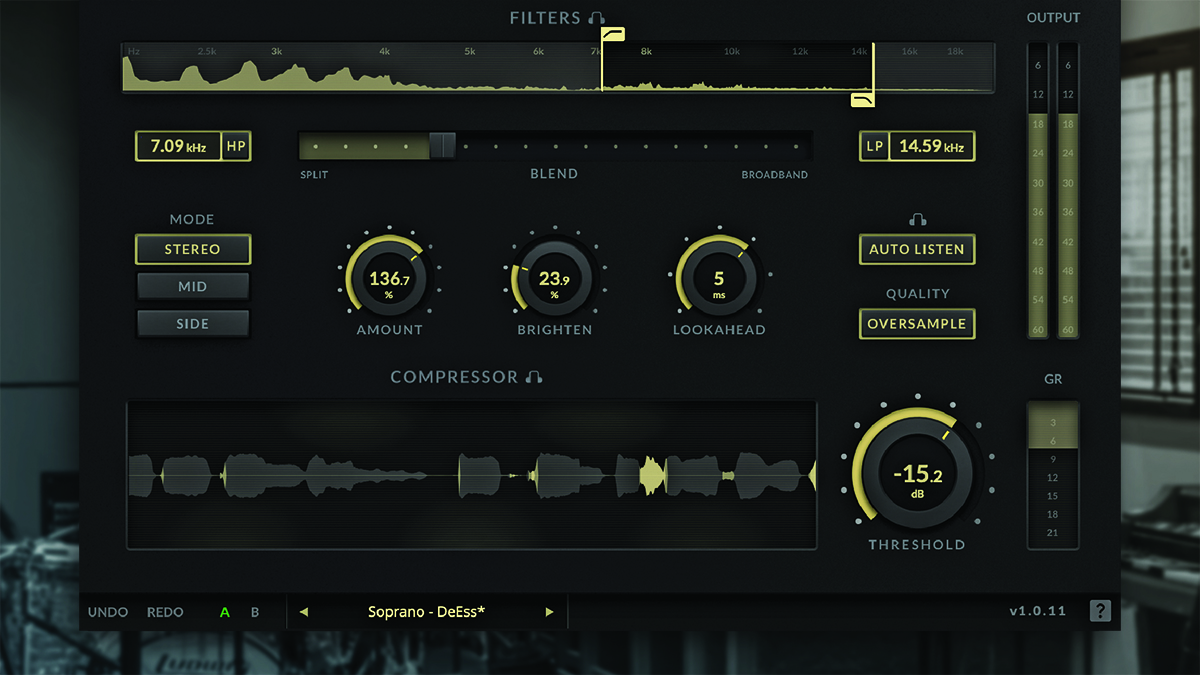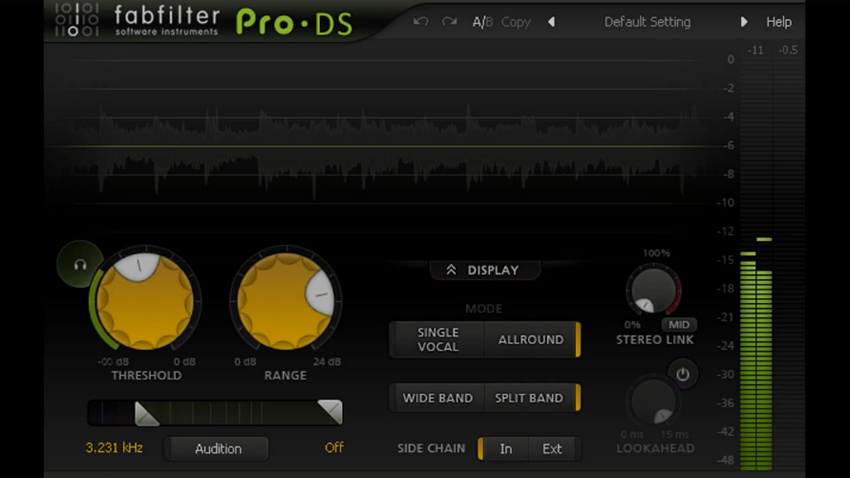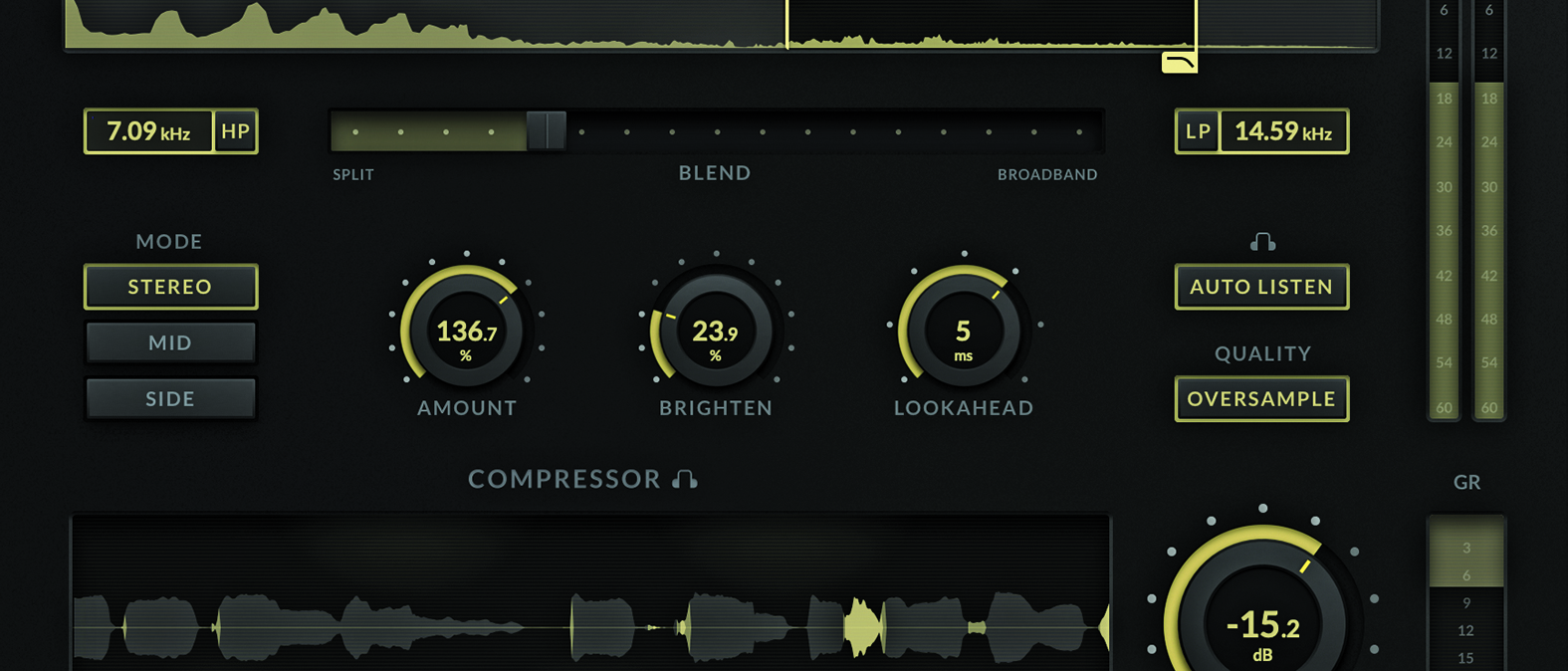MusicRadar Verdict
Ease of use and excellent visuals make this feature packed de-esser one of the best we’ve tried.
Pros
- +
Low and high-pass filters with smooth Butterworth profile.
- +
Effect listening for both compression and filters, with automatic listen option.
- +
Stereo, mid and side processing.
- +
Relative threshold for easy setup.
Cons
- -
Not much.
MusicRadar's got your back
Solid State Logic DeEss: What is it?
DeEss (VST, VST3, AU, AAX) from Solid State Logic is a new advanced de-esser plugin with a raft of cool features. Based around a detector circuit with super smooth high and low-pass Butterworth filters (third order), the plugin combines traditional features with some quite innovative ones, and is designed for both typical vocal de-essing and program material.
With that in mind you’ll find the default stereo mode is joined by MS modes Mid and Side. There’s also a Blend slider providing continuous adjustment between broadband and split band operation modes. Next, a Brighten control adds back high frequencies after the de-essing process. And finally you’ve got Oversample and Lookahead options to tweak the overall sonic performance.
DeEss’s interface includes plenty of visual feedback with a filter graph at the top, where you can also adjust the filter cutoffs, and a compression history graph at the bottom. Meanwhile on the right-hand side you’ll find gain reduction and output meters. The core compression controls are Amount (0 to 200%) and Threshold (0 to -24dB), and the latter is relative rather than absolute (see Relative threshold below for explanation). If at any stage you’re confused, the optional tool tips will usually save you a trip to the manual.

Solid State Logic DeEss: Performance and verdict
Getting started is really straightforward and you’ve got a selection of vocal and instrument presets. These apply task-focused filter settings, which is handy, leaving you to concentrate on setting the Amount and Threshold. If you want to start from scratch or simply want to hear what’s going on, there’s a filter sidechain listen option. This also works alongside Auto Listen, which if selected will activate the listen mode whenever you change the filter settings. You’ll find the compressor also has a listen function for monitoring just the compressed audio. This also works with the Auto Listen for both Threshold and Amount parameters.

• FabFilter Pro-DS
A powerful plugin with excellent visual feedback, loads of features and vocal and full program modes.
• Brainworx SPL De-Essers
Go authentic with these classic single band and dual band SPL emulating de-esser designs.
So how does it perform in practice? We tried DeEss on a number of different vocal performances, and have to say it coped very well. The relative threshold is pretty easy to set, which means we spent more time focusing on the sidechain filter settings and using the Blend control to decide how much of the signal to compress.
In fact, these two aspects are so flexible that you actually feel like you’re in control of the essing and can choose how you want to process it rather than just try to minimise it the best you can. For example, sometimes broadband de-essing, even of vocals, simply works better in context than split processing. With DeEss you have that option, but can also gradually back away from fully broadband to finesse the outcome. Couple that with independent low and high-pass filters and you really are spoilt for choice.
You actually feel like you’re in control of the essing and can choose how you want to process it
Understandably, this bodes well for treating program material or stereo blends, and the more we used DeEss the more we appreciated it as a frequency specific dynamics processor and not just a de-esser. That said, using the Mid and Side modes does require some care, particularly on program material, as both options can influence the stereo image.
Relative threshold
Most de-essers are straightforward frequency specific dynamics processors that use a fixed level threshold. This is simple to understand but also means they don’t handle variations in level very well, and it’s quite easy to end up overprocessing loud sibilance and underprocessing quiet sibilance.
To resolve this issue, DeEss uses a relative threshold. This helps to retain consistent de-esser behaviour across the whole performance no matter how loud or quiet it is. It also means that if you make changes in level prior to the DeEss plugin, it won’t completely undermine your settings, so DeEss should de-ess by the same amount as before.
As there’s no absolute threshold value, it’s not possible to plot a straight line threshold on the compression history graph. Nevertheless, the graph does include two tone shading and although this doesn’t display precisely when the threshold is reached, it does give an idea of the gain reduction applied.
Verdict
All told this is a very decent de-esser. It’s easy to use, with great features and excellent visuals, and is well up there with the market leaders
MusicRadar verdict: Ease of use and excellent visuals make this feature packed de-esser one of the best we’ve tried.
Solid State Logic DeEss: The web says
"This is a very powerful plugin capable of delivering a high-end sound which can feel extremely natural or not if you overdo it."
SonicScoop
Solid State Logic DeEss: Hands-on demos
SSLvideos
Solid State Logic DeEss: Specifications
- Mac: macOS Catalina (10.15), Big Sur (11), Monterrey (12). Intel Dual Core Mac running at 2.4GHz or higher. 4GB of RAM minimum, 8GB preferable. AU, VST2, VST3, AAX Native.
- Windows: Windows 10, 11. Intel Core 2 (or comparable) CPU running at 2.4GHz or higher. 4GB of RAM minimum, 8GB preferable. VST 2 (64-bit), VST3 (64-bit), AAX Native (64-bit).
- CONTACT: Solid State Logic
Computer Music magazine is the world’s best selling publication dedicated solely to making great music with your Mac or PC computer. Each issue it brings its lucky readers the best in cutting-edge tutorials, need-to-know, expert software reviews and even all the tools you actually need to make great music today, courtesy of our legendary CM Plugin Suite.
“Delivers streamlined DAW integration with an excellent hammer action keyboard”: Arturia Keylab 88 Mk3 review
“I have an original 909 – every time I try to use it I feel like I’m ruining it”: House hero Riva Starr on his studio essentials and his love of analogue synths
“A synthesizer that is both easy to use and fun to play whilst maintaining a decent degree of programming depth and flexibility”: PWM Mantis review











